Search the Special Collections and Archives Portal
Search Results
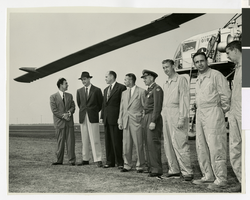
Photograph of Howard Hughes and others with the XH-17 helicopter, Culver City, California, October 23, 1952
Date
1952
Archival Collection
Description
Howard Hughes (second from left) standing in front of the experimental helicopter XH-17, Flying Crane, with others (from left to right): Rea Hopper, Director of the Aeronautical Division, Hughes Aircraft Company; Hughes; Clyde Jones, Director of Engineering, Hughes Tool Company Aeronautical Division; Warren Reed, Assistant; Colonel Carl E. Jackson from Air Research and Development Headquarters, Baltimore; Gale J. Moore, Pilot; possibly Chal Bowen, Flight Engineer/Co-pilot, and an unidentified man, on October 23, 1952.
Image
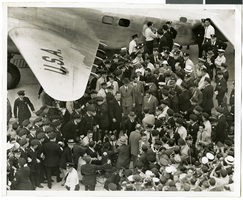
Photograph of crowds at Floyd Bennett Airfield, New York, July 1938
Date
1938-07-14
Archival Collection
Description
The black and white view of Howard Hughes exiting his Lockheed 14 aircraft after performing the final landing on the Round the World flight at Floyd Bennett Airport, New York. Description printed on photograph's accompanying sheet of paper: "Telling the world about the record-smashing flight. New York City--Under the giant wing of the huge Lockheed plane, radio men set up their microphones so that Howard Hughes and his gallant crew of four can send a few words of greeting to the world over the air waves after landing at Floyd Bennett Field on their record-smashing flight around the world. Credit Line (ACME) 7/14/38"
Image

Photograph of people in Boulder City Hotel, Boulder City (Nev.), 1970s
Date
1970 to 1979
Archival Collection
Description
People lounging in the redone Boulder City Hotel, Boulder City, 1970s.
Image
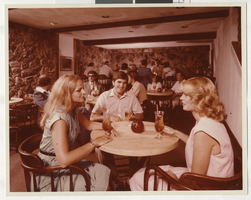
Photograph of people in the Boulder City Hotel, Boulder City (Nev.), 1970s
Date
1970 to 1979
Archival Collection
Description
Group of people drinking in the remodeled Boulder City Hotel, Boulder City, 1970s.
Image
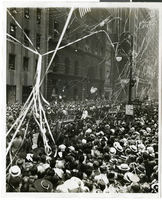
Photograph of a parade procession, New York, July 15, 1938
Date
1938-07-15
Archival Collection
Description
Description printed on photograph's accompanying sheet of paper: "Howard Hughes and crew in parade up Broadway after record-breaking world flight. New York, New York."
Image
Traffic Ordinance for the City of Las Vegas, Nevada, 1931 July 14
Level of Description
File
Archival Collection
Leon Rockwell Papers
To request this item in person:
Collection Number: MS-00013
Collection Name: Leon Rockwell Papers
Box/Folder: Box 02
Collection Name: Leon Rockwell Papers
Box/Folder: Box 02
Archival Component
#00773: Cedar City Shakespeare Festival - prepublicity, 1973 July 03
Level of Description
File
Archival Collection
University of Nevada, Las Vegas Creative Services Records (1970s)
To request this item in person:
Collection Number: PH-00388-01
Collection Name: University of Nevada, Las Vegas Creative Services Records (1970s)
Box/Folder: N/A
Collection Name: University of Nevada, Las Vegas Creative Services Records (1970s)
Box/Folder: N/A
Archival Component
City of Las Vegas, advisory committee member, 1983 July 20
Level of Description
File
Archival Collection
Anna Dean Kepper Papers
To request this item in person:
Collection Number: MS-00279
Collection Name: Anna Dean Kepper Papers
Box/Folder: Box 02
Collection Name: Anna Dean Kepper Papers
Box/Folder: Box 02
Archival Component
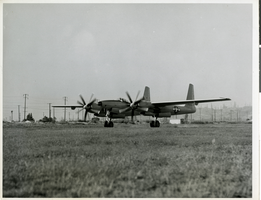
Photograph of the XF-11 as it is about to take off for its first test flight in Culver City, California July 7, 1947
Date
1947
Archival Collection
Description
Transcribed from attachment to photo: "NEW LONG-RANGE PLANE ANNOUNCED CULVER CITY, CALIF., The FX-11 took off today on its first test flight. One of the world's fastest long-range photographic planes, it was designed and built by Howard Hughes in conjunction with Air Materiel Command engineers. It has a wing spread of 101 feet, 4 inches, and is powered by two 3000-horsepower radial engines with eight-bladed contra-rotating propellers. Army officials said it can attain a speed of more than 400 miles per hour and has a ceiling of more than 40,000 feet." Transcribed from photo sleeve: "Howard Hughes sits in the cockpit of the XF-11, a reconnaissance plane that Hughes built and designed in conjunction with Air Materiel Command engineers. Hughes is preparing for his first test flight in Culver City, California July 7, 1947."
Image
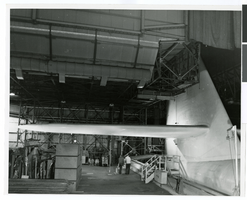
Photograph of the interior of an airplane hangar at the Hughes Helicopters Division of Summa Corporation, Culver City, California, circa late 1950s
Date
1957 to 1959
Archival Collection
Description
A view of the inside of an airplane hangar at the Hughes Helicopters Division of Summa Corporation in Culver City, California in the late 1950s.
Image
Pagination
Refine my results
Content Type
Creator or Contributor
Subject
Archival Collection
Digital Project
Resource Type
Year
Material Type
Place
Language
Records Classification
